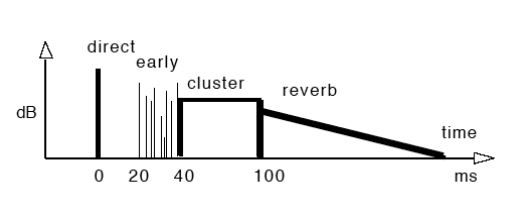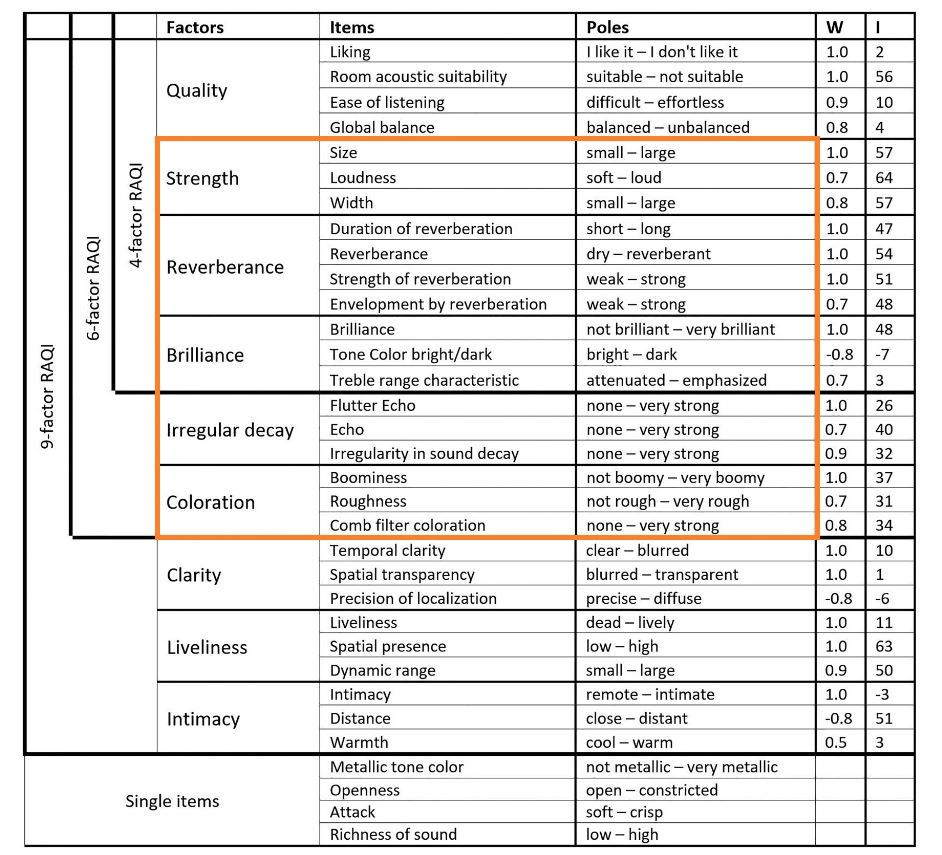Reverberance
Source Strenght
Tonal Colour
Attributes of Acoustic Spaces
This lexicon includes the perceptual attributes used to describe different acoustic spaces, recently identified by Stefan Weinzierl et al. in the article Room Acoustical Quality Inventory published in 2018. It is also composed of attributes from the Ircam Spatialiser (Spat) developed from the work of Jean-Pascal Jullien and Olivier Warusfel, and the theses of Catherine Lavandier (1989) and Ekhard Kahle (1995). The title of this lexicon, "Attributes of Acoustic Spaces", refers to the formula "Attributes of Spaces" used by Francis Rumsey in his article (2002).
The terms gathered in this lexicon make it possible to describe the sound in an enclosed space, taking into account the integration of the sound source in this space, and the acoustic quality of the place. Several sound examples have been produced in order to facilitate the understanding of the terms.
The work of lexical selection and creation of the sound examples was carried out by Justin Valette, student of the DNSEP Design Sonore of the Ecole Nationale Supérieure d'Art et de Design TALM Le Mans, and intern for 4 months in the Perception et Design Sonores team of Ircam; supervised by Patrick Susini and Olivier Houix, researchers in the team, with the support of Augustin Muller, director of music informatics at Ircam.
Most of the sound examples were created using the Ircam Spatialiser (Spat 5). This tool allowed the elaboration of examples illustrating the main perceptual factors proposed by the RAQI. Other examples were obtained from the impulse responses of rooms, extracted from the corpus of Lieux Perdus by Augustin Muller and Pedre Garcia-Velasquez, the Open Air library, and the Impulse Responses by Fokke van Saane. The impulse responses chosen to illustrate the perceptual factors were selected by Justin Valette.
These examples are encoded in binaural format, so it is important to prefer listening through headphones to perceive the encompassing aspect of certain attributes, such as Envelopment.
For a better understanding of the definitions, here is a figure illustrating the decomposition of a room's response, as thought in Spat.
This figure comes from the Spatialiser documentation.
- Direct: the direct wave, coming from the source,
- Early: the first reflections (reflected once on the walls),
- Cluster: the secondary reflections (reflected more than once on the walls),
- Reverb: the reverberation, a mix of early reflections and secondary reflections, giving a confused sound that gradually decreases.
The perceptual factors described in this lexicon are classified into four categories:
The factors of the RAQI:
Reverberance: Perceptual factor related to reverberation, including its length and loudness.
Brilliance: Perceptual characteristics associated with the frequency organisation, i.e. the balance between bass and treble, of a source and a space.
Source Strength: Perceptual characteristics of the source in a space; for example, its size and sound level.
Irregular Decay: Perceptual factors that account for irregularity in the decay of reverberation, such as an echo.
Spat factors:
- Spat factors : Frequency band decay: Perceptual factors related to the decay time of the reverberation level separated by frequency bands.
(Spat factors have been added to the lexicon to complement the RAQI "Brilliance" factor).
The choice of sources was inspired by the work of the RAQI. Its authors have chosen various sources : an ensemble of instruments, a declaimed voice, and a solo instrument. In the case of this lexicon, we chose a trumpet phrase, a spoken voice, a guitar, and some short and impulsive sources including a clarinet note and a female voice, in order to provide diversity of content and behaviour of the space according to the parameters of the room response.
To gather the RAQI terms, researchers at the Technical University of Berlin surveyed the vocabulary of room acoustics from experts. Multiple perception tests on 190 subjects, both initiated and uninitiated, and factor analyses made it possible to select 33 terms from the entire vocabulary and to establish three levels of accuracy for describing room acoustics: the 4-factor, 6-factor, and 9-factor RAQI. Concerning the PSAT model, the IRCAM researchers, Jean-Pascal JULLIEN, Catherine LAVANDIER, and Ekhard KAHLE, proceeded systematically by associating perceptual factors to the criteria usually used to describe room acoustics; for example, the "TR" factor (reverberation time) is linked to the "reverberation" factor.
Weinzierl, S., Lepa, S., & Ackermann, D. (2018). A measuring instrument for the auditory perception of rooms: The Room Acoustical Quality Inventory (RAQI). The Journal of the Acoustical Society of America, 144(3), 1245-1257.
Rumsey, F. (2002). Spatial quality evaluation for reproduced sound: Terminology, meaning, and a scene-based paradigm. Journal of the Audio Engineering Society, 50(9), 651-666.
Jullien, J.-P., Kahle, E., Warusfel, O., and Winsberg, S. (1992). Some results on the objective characterization of room acoustic quality in both laboratory and real environments. In Proceedings of the Institute of Acoustics XIV, Birmingham, number 2.
Kahle, E. (1995). Validation d'un modèle objectif de la perception de la qualité acoustique sur un ensemble de salles de concert et d'opéra. PhD thesis, Université du Maine, Le Mans.
Lavandier, C. (1989). Validation perceptive d'un modèle objectif de caractérisation de la qualité acoustique des salles. PhD thesis, Université du Maine, Le Mans.

